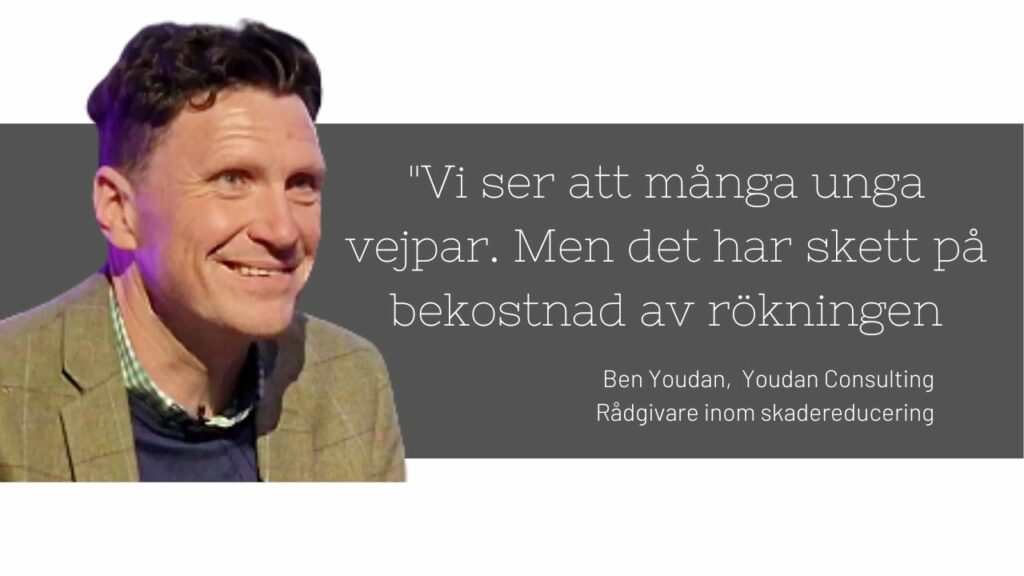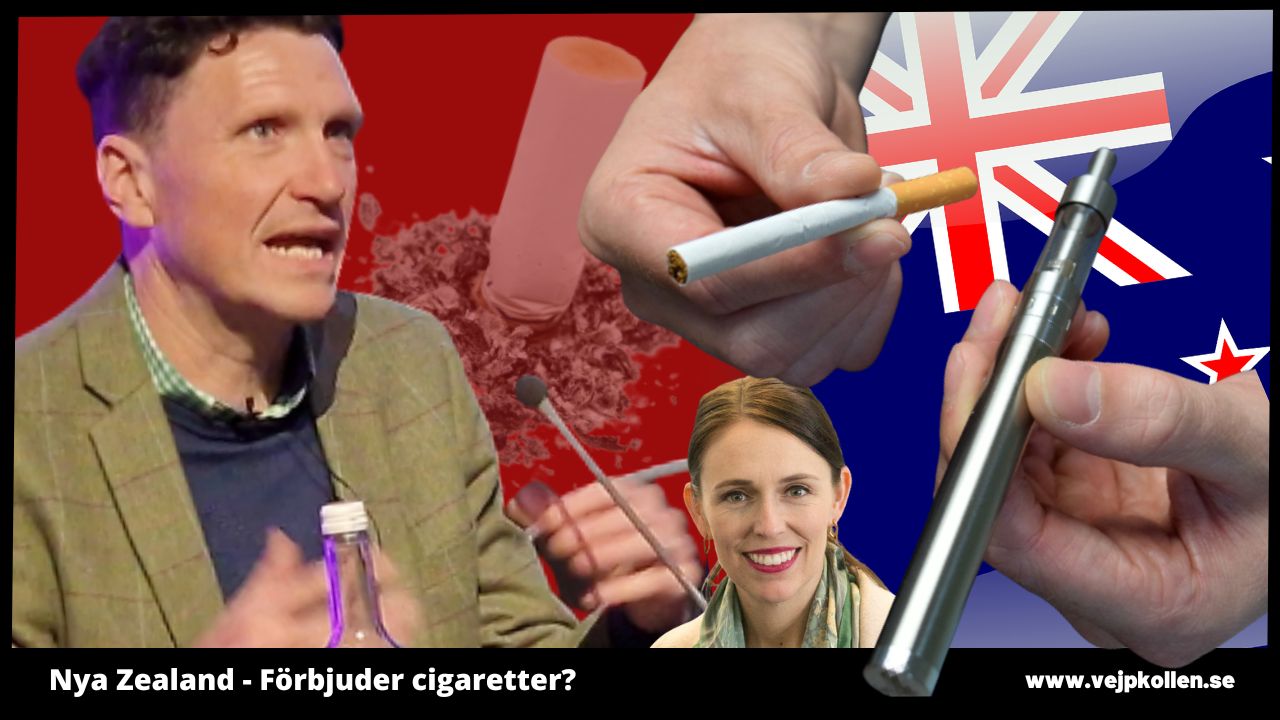New Zealand's controversial policy to reduce smoking, with bans and low-nicotine cigarettes, is attracting worldwide attention. But what's really going on? Vejpkollen takes a deep dive into a strategy that has strong roots in harm reduction - with e-cigarettes and vejping playing a central role.
Vejpkollen monitors E-cigarette summit London 2022
Reporter: Stefan Mathisson
Cigarettes with extremely low nicotine content. A generational ban on buying them and only a few shops allowed to sell smoking tobacco. As Vejpkollen previously reported New Zealand's radical measures to reduce smoking have received worldwide attention.
"But it is very important that everyone understands the background. It is about harm reduction and a conscious strategy to promote e-cigarettes, products with a relatively lower risk of harm compared to cigarettes. Without this, no one would have dared to think about the idea of effectively banning cigarettes," said Mr Higgins. Ben Youdan, political consultant and former head of the Action on Smoking and Health in New Zealand.
"People wanted safer nicotine"
The groundwork for a 'Tobacco Endgame' in New Zealand was actually laid 12 years ago. In 2010, a parliamentary inquiry set a date for a 'smoke-free New Zealand' by 2025. The goal was to reduce the proportion of smokers in the population to less than five per cent.
"But the inquiry also recognised that many New Zealanders wanted access to more and safer ways to use nicotine. This was recognised. Since then, harm minimisation has been an important part of the New Zealand anti-smoking strategy," he says. Ben Youdan, when he presents the New Zealand strategy at the New Zealand Parliament. E-cigarette summit 2022 in London.
Low risk profile
E-cigarettes and Swedish snus were some of the examples that the investigation highlighted as important tools in the strategy. At the time, e-cigarettes were a relatively unknown product.
"But local researchers convinced policy makers of its relatively low risk profile compared to smoking. Moreover, it was judged that the absolute risks were likely to be low" says Ben Youdan.
Regulation of e-cigarettes
The next 10 years saw the launch of what became one of the world's toughest cigarette laws. As the country sharply increased taxes on smoking tobacco, restricted marketing, and regulated the appearance of packaging, it also allowed e-cigarettes to take their place alongside cigarettes, without extensive regulation.
When the authorities later measured the use of e-cigarettes in 2018, the strategy proved to be effective. And by a wide margin, says Ben Youdan.
"We saw a steady decline in smoking rates across the population. At the same time, we saw a rapid increase in vejping once the products hit the market. Having worked in tobacco control for over 20 years, I couldn't believe my eyes when I saw it. It was clear that there was a link between the measures and the switch to vejp, although we could not prove a clear causal relationship. We saw it in particular among young people and among the indigenous Mauri, groups that have long had high rates of smoking," says Ben Youdan.
Tougher rules since 2021
Since 2021, New Zealand has been building a regulatory framework also for e-cigarettes. This means that e-cigarettes are subject to an 18-year age limit, require registration and systematic feedback on health effects to health authorities. Not unlike the system in the EU, the UK and Sweden. But it also meant restrictions on flavourings and that e-cigarettes could not be sold anywhere or anyhow.
"For example, ordinary shops are not allowed to sell anything other than closed systems with a maximum nicotine content of 20mg/ml. They may also only be flavoured with tobacco and menthol flavours. However, specialist shops, those who derive their main income from vejp products, are allowed to sell all flavours and devices as well as slightly higher nicotine levels". Ben Youdan.
High uptake among young people
At the same time, authorities invested in extensive stop-smoking campaigns and funded websites such as provided information on e-cigarettes as harm minimisation and as an effective tool for smoking.
"Overall, e-cigarettes are more heavily regulated than cigarettes today. Despite this, we see a large uptake among young people. But this has been at the expense of smoking. Today, less than 1 per cent of young people smoke daily. Around 10 per cent vejpar. " Notes Ben Youdan.
Low nicotine cigarettes
The 12 December 2022 New Zealand took the next step in reducing smoking in the country. A decision to force nicotine levels in cigarettes to extremely low levels, as well as a ban on selling cigarettes to those born after 2008, was passed in December 2022. The measure has had a major impact in the the media around the world. Men Ben Youdan is not sure that the new legislation is the right way to go.
'If we take a closer look at the trends we have seen in recent years, it becomes clear that we are already on the right track, if we just keep doing what we are doing. Smoking will be below five per cent by 2025. Among young people, 1 per cent smoke daily, while 10 per cent vejpar. We already have a smoke-free generation and the explanation for this lies in a clear strategy where e-cigarettes, i.e. harm minimisation, have been given a central role," says the Commissioner. Ben Youdan.

Emphasising unnecessary risks
De-nicotinising cigarettes and introducing a controversial ban is therefore not necessary to reduce smoking, says Ben Youdan. He describes it more as a matter of principle, fuelled by political prestige.
"The result is a measure that could have unforeseen consequences, not least for the elderly who still want to smoke. It becomes a coercive measure, which is not really necessary," he says.
Ben Youdan also emphasises the risks of a black market, which will grow as long as there is a demand for "regular" cigarettes.
Harm minimisation is key
But it is the lack of communication about the strategy as a whole that is of particular concern. Ben Youdan. He lacks the big picture, especially when news of the "cigarette ban in New Zealand" is spreading around the world.
"I think we should be very open when we talk about the reasons behind New Zealand's success in tackling smoking. We need to emphasise the real reasons. That is, tough legislation on cigarettes combined with harm minimisation. That's what made these measures possible. Otherwise, there is a great risk that other countries will follow suit, without understanding the background, and then things can get really bad," says Mr Higgins. Ben Youdan.
The ban impossible without alternatives
Also the Prime Minister of New Zealand Jacinda Arden has clearly stated that vejping and e-cigarettes are the basis for the decision to introduce the new age restriction, as well as the requirement for low-nicotine cigarettes.
"We have seen that smokers now have a viable alternative way to use nicotine. It is this development that gives us the courage to take the next step in phasing out cigarettes from the market," said Mr Van Rompuy. Jacinda Arden in a statement 2021when the government presented the proposal that has now become law.
"Politicians in the world are missing the point"
However, while the Prime Minister has been clear, according to the Ben Youdan It is all too easy for the media and politicians to simply miss an important message. The simplified version is easier to digest, especially as there are differences of opinion on the role of harm minimisation in the fight against smoking.
"I recently read an article about our new law in an Australian newspaper. There was not a single mention of harm minimisation or e-cigarettes. It was all about toughness, low nicotine levels in cigarettes and the different age restriction. There is a risk that politicians in other countries will miss the point and be tempted to introduce legislation that is unlikely to work," he said. Ben Youdan.




